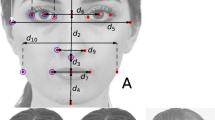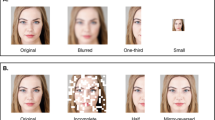Abstract
Anecdotally, spouses are often said to resemble one another. This study investigates the effects of similarity between participants and stimuli on judgements of facial attractiveness: does “like prefer like”? Using computer graphic techniques, opposite sex facial stimuli were generated from subjects' photographs. Experiment 1 showed a correlation between attractiveness and similarity but the effect can be explained by the attractiveness of average faces. Beyond this, there was a trend for individual subjects to rate opposite sex images with a similar face shape to their own face as more attractive than other subjects. Experiment 2 allowed subjects to interactively manipulate an opposite sex facial image along a continuum from a self-similar shape, through an average face shape, to a face with opposite characteristics. No significant preferences for self-similar or opposite characteristics were found. Preferences for average faces are stronger than preferences for self-similar faces.
Similar content being viewed by others
References
Allison, D.B., Neale, M.C., Kezis, M.I., Alfonso, V.C., Heshka, S., and Heymsfield, S.B. (1996). Assortative mating for relative weight: genetic implications. Behavior Genetics, 26,103–111.
Bateson, P. (1982). Preferences for cousins in Japanese Quail. Nature 295, 236–237.
Bateson, P. (1983). Optimal outbreeding. In: Mate Choice, P. Bateson (ed.). Cambridge: Cambridge University Press, p. 257–277.
Bateson, P. (1988). Preferences for close relations in Japanese Quail. H. Ouellet. Ottawa: University of Ottawa Press. Acta XIX Congressus Internationalis Ornithologici, 1, 961–972.
Benson, P.J. and Perrett, D.I. (1992). Face to face with the perfect image. New Scientist, 133, 32–35.
Berscheld, E., Dion, K., Walster, E., and Walster, G.W. (1971). Physical attractiveness and dating choice: a test of the matching hypothesis. Journal of Experimental Social Psychology, 7, 173–189.
Burley, N.(1983). The meaning of assortative mating. Ethology and Sociobiology, 4,191–203.
Clark, P.J. and Spuhler, J.N. (1959). Differential fertility in relation to body dimensions. Human Biology, 31,121–137.
Dawkins, R. (1979). Twelve misunderstandings of kin selection. Zeitschrift fur Tierpsychologie, 51, 184–200.
D'Udine, B. and Alleva, E. (1981). Early experience and sexual preferences in rodents. In: Mate Choice, P. Bateson (ed.). Cambridge: Cambridge University Press, 311–330.
Epstein, E. and Guttman, R. (1982). Mate selection in man: Evidence, theory, and outcome. Social Biology, 31, 243–276.
Grammer, K. and Thornhill, R. (1994). Human (homo sapiens) facial attractiveness and sexual selection: the role of symmetry and averageness. Journal of Comparative Psychology, 108, 233–242.
Griffiths, R.W. and Kunz, P.R. (1973). Assortative mating: A study of physiognomic homogamy. Social Biology, 20,448–4153.
Hill, C.T., Rubin, Z., and Peplau, L.A. (1976). Breakups before marriage: The end of 103 affairs. Journal Social Issues, 32, 147–168.
Hinsz, V.B. (1989). Facial resemblance in engaged and married couples. Journal of Social and Personal Relationships, 6, 223–229.
Holmes, W.G. and Sherman, P.W. (1983). Kin recognition in animals. American Scientist, 71,46–55.
Immelman, K. (1975). Ecological significance of imprinting and early learning. Annual Review of Ecology and Systematics,6, 15–37.
Jones, D. (1995). Sexual selection, physical attractiveness, and facial neoteny. Current Anthropology, 36, 723–748.
Kendrick, K.M., Hinton. M.R., and Atkins, K. (1998). Mothers may irreversibly determine male social and sexual preferences. Nature, 395, 229–230.
Langlois, J.H. and Roggman. L.A. (1990). Attractive faces are only average. Psychological Science, 1, 115–121.
Malina, R.M., Selby, H. A. Buschang, P.H., Aronson, W. L., & Little, B.B. (1983). Assortative mating for phenotypic characteristics in a Zapotec community in Oaxaca, Mexico. Journal of Biosocial Science, 15, 273–280.
Ober, C, Hyslop, T., Elias, S., Weitkamp, L.R., and Hauck, W.W. (1998). Human Leukocyte antigen matching and fetal loss—results of a ten year prospective study. Human Reproduction, 13,33–38.
Partridge. L. (1983). Non-random mating and offspring fitness. In: Mate Choice, P. Bateson (ed.). Cambridge: Cambridge University Press, p. 227–256.
Perrett, D.I., Lee, K.J., Penton-Voak, I.S., Rowland, D.R., Yoshikawa, S., Burt, D.M., Henzi, S.P., Castles, D.L., and Akamatsu, S. (1998). Effects of sexual dimorphism on facial attractiveness. Nature, 394, 884–887.
Perrett, D.I., May, K.A., and Yoshikawa, S. (1994). Facial shape and judgements of female attractiveness. Nature, 368, 239–242.
Rabin, I.A. (1965). Growing up in a Kibbutz. New York: Springer.
Roberts, D.F. (1977). Assortative mating in man: Husband/wife correlations in physical characteristics. Supplement to the Bulletin of The Eugenics Society, 2.
Rowland, D.A. and Perrett, D.I. (1995). Manipulating facial appearance through shape and color. IEEE Computer Graphics and Applications, 15, 70–76.
Rushton, J.P. (1988). Genetic similarity, mate choice, and fecundity in humans. Ethology and Sociobiology, 9, 329–333.
Rushton, J.P. (1989). Genetic similarity, human altruism, and group selection. Behavioral and Brain Sciences, 12, 503–559.
Seemanova, E. (1971). A study of the children of incestuous matings. Human Heredity, 21,108–128.
Shepher, J. (1971). Mate selection among second generation Kibbutz adolescents and adults: Incest avoidance and negative imprinting. Archives of Sexual Behavior, 1, 293–307.
Shepherd, J.W. and Ellis, H.D. (1972) The role of physical attractiveness in selection of marriage partners. Psychological Reports, 30, 1004.
Spiro, M.E. (1965). Children of the Kibbutz. New York: Schocken Books.
Spuhler, J.N. (1968). Assortative mating with respect to physical characteristics. Eugenics Quarterly, 15, 128–140.
Symons, D. (1979). The evolution of human sexuality. Oxford: Oxford University Press.
Talmon, Y. (1964). Mate selection in collective settlements. American Sociological Review, 29,491–508.
Thiessen, D. and Gregg, B. (1980). Human assortative mating and genetic equilibrium: An evolutionary perspective. Ethology and Sociobiology, 1, 111–140.
Thornhill, R. and Gangestad, S.W. (1993). Human facial beauty: Averageness, symmetry, and parasite resistance. Human Nature, 4, 237–269.
Thornhill, R. and Gangestad, S.W. 1996). The evolution of human sexuality. Trends in Evolution and Ecology, 11,98–102.
Vandenberg, S.G. (1972). Assortive mating or who marries whom? Behavior Genetics, 2,127–157.
Vos, D.R. (1994). Sex recognition in zebra finch males results form early experience. Behaviour, 128, 1–14.
Vos, D.R. (1995a). The role of sexual imprinting for sex recognition in zebra finches: a difference between males and females. Animal Behavior, 50, 645–653.
Vos, D.R. (1995b). Sexual imprinting in zebra-finch females: Do females develop a preference for males that look like their father? Ethology, 99, 252–262.
Waldman, B. (1987). Mechanisms of kin recognition. Journal of Theoretical Biology, 128, 159–185.
Wedekind. C, Seebeck, T., Bettens, F., and Paepke, A.J. (1995). MHC-dependent mate preferences in humans. Proceedings of the Royal Society of London B., 260, 245–249.
Westermarck, E. (1894). The History of Human Marriage. London: Macmillan.
Wilson, G.D. and Barrett, P.T. (1987). Parental characteristics and partner choice: Some evidence for Oedipal imprinting. Journal of Biosocial Science, 19,157–161.
Wolf, A.P. (1993). Westermarck Redivivus. Annual Review of Anthropology, 22,157–175.
Wright, S. (1933). The roles of mutation, inbreeding, crossbreeding, and selection in evolution. Proceedings of the VIth International Conference on Genetics, New York: Brooklyn Botanic Garden.
Zajonc, R.B., Adelmann, P.K., Murphy, S.T., and Niendenthal, P.M. (1987). Convergence in the physical appearance of spouses. Motivation and Emotion, 11, 335–346.
Zei, G., Astofli, P., and Jayakar. S.D. (1981). Correlation between father's age and husband's age: A case of imprinting? Journal of Biosocial Science, 13,409–418.
Author information
Authors and Affiliations
Rights and permissions
About this article
Cite this article
Voak, I.S.P., Perrett, D.I. & Peirce, J.W. Computer graphic studies of the role of facial similarity in judgements of attractiveness. Curr Psychol 18, 104–117 (1999). https://doi.org/10.1007/s12144-999-1020-4
Issue Date:
DOI: https://doi.org/10.1007/s12144-999-1020-4




